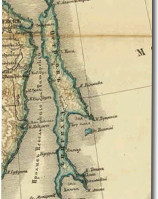
Regulations on reorganization of Sakhalin Island’s governance approved
According to the Regulations on reorganization of Sakhalin Island’s governance approved by Emperor Alexander III on May 15 (27), 1884, the island, which had been under the control of the military governor of Primorye Region, became an independent administrative unit, which was under the authority of the Governor General of Eastern Siberia.
Sakhalin became part of Amur Governorate in June 1884. Administratively, the island was divided into three districts: Aleksandrovsky, Tymovsky and Korsakovsky. Governor General of Amur Region was the chief official, whereas the local administration was under the control of the head of the island. The head of the island was appointed from military generals by order of the emperor upon the proposal of the Minister of Internal Affairs and by the Highest Order of the Military Directorate. Major-General Andrei Gintse, who had considerable experience of army service in other parts of Russia, was appointed the first head of the island. The appointment of Gintse took place on July 14 (26), 1884. The apparatus of the head of Sakhalin consisted of the clerical office and departmental specialists: a head of the medical unit, an agricultural inspector, a mining engineer-architect, a land surveyor. The clerical office included a head of the office, a clerk, an accountant and his assistants, a treasurer, a Japanese and Gilyak languages translator, and copyists. The head of the island exercised the rights and fulfilled duties of a governor, a council and other institutions of the governorate. He also carried out the duties of political control of individuals and had a right to exile them from Sakhalin in case of the bad influence on convicts and exiles.
Another level of administration included heads of districts, who managed the convict prisons and settlements of exiles, as well as district police departments. The police departments were in charge of all administrative matters. They also fulfilled judicial functions in civil suits (less than 30 rubles), performed the duties of brokers and notaries. In total, the island’s administrative staff consisted of 62 people.
The regulations of 1884 established the rights and powers of Sakhalin governors, who performed military, police and civil control; developed the staff of the local administration, which was responsible for most of the current issues. Another part of the regulations of 1884 was the Highest resolution of the State Council of November 27 (December 9), 1884 concerning the military administration of the region. The local troops were under the authority of the head of the island, who had the rights of the division commander and was subordinate to the commander of the Amur Military District. Sakhalin Island represented a particular administrative region, governed by one person, in whose hands great powers were concentrated. This was largely due to the remoteness of the region from the center, the lack of reliable communications, what made it impossible to efficiently control Sakhalin from St.Petersburg. Thus, as a result of the reorganizations of 1884, a new administrative apparatus was formed, which changed the previously established administrative system of the island, regulated the activities of local authorities, established the powers and rights of its main units. Further instructions only supplemented the power structure developed by this legislative act, which existed in Sakhalin until 1909.
Lit.: Гридяева М. В. Реформирование управления в 80-е годы XIX века // Остров Сахалин во второй половине XIX – начале XX века : адм. устройство и упр. Южно-Сахалинск, 2008. С. 29–43; Летопись Южно-Сахалинска, 1882–2005 : история города со времени основания до наших дней. Южно-Сахалинск, 2006. С. 99; Костанов А. Освоение Сахалина русскими людьми. Южно-Сахалинск, 1991. С. 53–54.
Based on the Presidential Library’s materials:
Sakhalin Region: pages of history: [digital collection].
The materials were provided by the Sakhalin Regional Universal Research Library

